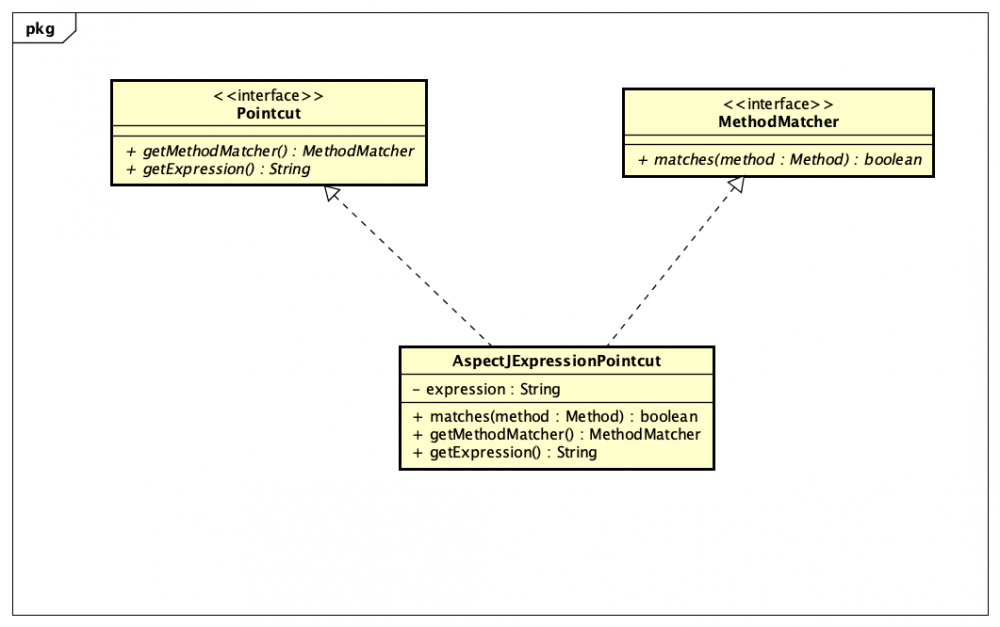Small Spring系列八:aop (一)
路漫漫其修远兮 吾将上下而求索。

概述
我们终于不辱使命完成了 Spring 的注解注入,接下来我们要实现更为关键 aop 部分,在这开始之前你需要了解什么事 aop 以及 aop 的常用术语,参考 链接
准备工作
bean-v5.xml
我们使用 xml 配置的方式实现aop
<?xml version="1.0" encoding="UTF-8"?>
<!-- 增加namespace-->
<beans xmlns="http://www.springframework.org/schema/beans"
xmlns:context="http://www.springframework.org/schema/context"
xmlns:aop="http://www.springframework.org/schema/aop">
<!-- 扫描哪个包下面的文件 -->
<context:component-scan base-package="com.niocoder.dao.v5,com.niocoder.service.v5">
</context:component-scan>
<!-- 模拟 TransactionManager-->
<bean id="tx" class="com.niocoder.tx.TransactionManager"/>
<!-- aop 配置-->
<aop:config>
<!-- aop 核心配置 依赖tx-->
<aop:aspect ref="tx">
<!-- 切入点配置 包下面的placeOrder 方法-->
<aop:pointcut id="placeOrder"
expression="execution(* com.niocoder.service.v5.*.placeOrder(..))"/>
<!-- 通知配置,-->
<aop:before pointcut-ref="placeOrder" method="start"/>
<aop:after-returning pointcut-ref="placeOrder" method="commit"/>
<aop:after-throwing pointcut-ref="placeOrder" method="rollback"/>
</aop:aspect>
</aop:config>
</beans>
AccountDao
package com.niocoder.dao.v5;
import com.niocoder.stereotype.Component;
@Component
public class AccountDao {
}
ItemDao
package com.niocoder.dao.v5;
import com.niocoder.stereotype.Component;
@Component
public class ItemDao {
}
NioCoderService
新增 placeOrder 方法用于测试 aop , MessageTracker 用于测试 TransactionManager 是否执行。
package com.niocoder.service.v5;
import com.niocoder.beans.factory.Autowired;
import com.niocoder.dao.v5.AccountDao;
import com.niocoder.dao.v5.ItemDao;
import com.niocoder.stereotype.Component;
import com.niocoder.util.MessageTracker;
@Component("nioCoder")
public class NioCoderService {
@Autowired
AccountDao accountDao;
@Autowired
ItemDao itemDao;
public NioCoderService() {
}
public AccountDao getAccountDao() {
return accountDao;
}
public ItemDao getItemDao() {
return itemDao;
}
public void placeOrder() {
System.out.println("place order");
MessageTracker.addMsg("place order");
}
}
MessageTracker
工具类用于记录 msg
package com.niocoder.util;
import java.util.ArrayList;
import java.util.List;
/**
* 记录msg
*/
public class MessageTracker {
private static List<String> MESSAGES = new ArrayList<>();
public static void addMsg(String msg) {
MESSAGES.add(msg);
}
public static void clearMsgs() {
MESSAGES.clear();
}
public static List<String> getMsgs() {
return MESSAGES;
}
}
TransactionManager
模拟事务的执行。
package com.niocoder.tx;
import com.niocoder.util.MessageTracker;
import org.junit.Before;
/**
* 用于测试AOP顺序
*/
public class TransactionManager {
@Before
public void setUp() {
MessageTracker.clearMsgs();
}
public void start() {
System.out.println("start tx");
MessageTracker.addMsg("start tx");
}
public void commit() {
System.out.println("commit tx");
MessageTracker.addMsg("commit tx");
}
public void rollback() {
System.out.println("rollback tx");
}
}
Pointcut
<aop:pointcut id="placeOrder"
expression="execution(* com.niocoder.service.v5.*.placeOrder(..))"/>
我们先从最简单的 Pointcut 开始,很明显我们需要一个类来表达这个概念。当给定一个类的方法,判断该方法是否符合 pointcut 的表达式。设计类图如下: 
关于 expression 表达式的解析,我们使用 org.aspectj.aspectjweaver 来实现。所以需要在 pom.xml 中添加依赖
<dependency>
<groupId>org.aspectj</groupId>
<artifactId>aspectjweaver</artifactId>
<version>1.8.13</version>
</dependency>
MethodMatcher
给定一个类的方法,判断是否匹配。
package com.niocoder.aop;
import java.lang.reflect.Method;
public interface MethodMatcher {
/**
* 给定一个方法判断是否匹配
*
* @param method
* @return
*/
boolean matches(Method method /*,Class<?> targetClass*/);
}
Pointcut
获取 expression 和 MethodMatcher 。
package com.niocoder.aop;
public interface Pointcut {
/**
* 获取MethodMatcher 判断方法时候匹配
*
* @return
*/
MethodMatcher getMethodMatcher();
/**
* 获取expression表达式
*
* @return
*/
String getExpression();
}
AspectJExpressionPointcut
实现 MethodMatcher 和 Pointcut ,使用 aspectj 实现。
package com.niocoder.aop.aspectj;
import com.niocoder.aop.MethodMatcher;
import com.niocoder.aop.Pointcut;
import com.niocoder.util.ClassUtils;
import com.niocoder.util.StringUtils;
import org.aspectj.weaver.reflect.ReflectionWorld;
import org.aspectj.weaver.tools.*;
import java.lang.reflect.Method;
import java.util.HashSet;
import java.util.Set;
public class AspectJExpressionPointcut implements Pointcut, MethodMatcher {
private static final Set<PointcutPrimitive> SUPPORTED_PRIMITIVES = new HashSet<PointcutPrimitive>();
static {
SUPPORTED_PRIMITIVES.add(PointcutPrimitive.EXECUTION);
SUPPORTED_PRIMITIVES.add(PointcutPrimitive.ARGS);
SUPPORTED_PRIMITIVES.add(PointcutPrimitive.REFERENCE);
SUPPORTED_PRIMITIVES.add(PointcutPrimitive.THIS);
SUPPORTED_PRIMITIVES.add(PointcutPrimitive.TARGET);
SUPPORTED_PRIMITIVES.add(PointcutPrimitive.WITHIN);
SUPPORTED_PRIMITIVES.add(PointcutPrimitive.AT_ANNOTATION);
SUPPORTED_PRIMITIVES.add(PointcutPrimitive.AT_WITHIN);
SUPPORTED_PRIMITIVES.add(PointcutPrimitive.AT_ARGS);
SUPPORTED_PRIMITIVES.add(PointcutPrimitive.AT_TARGET);
}
/**
* 条件表达式 即 expression="execution(* com.niocoder.service.v5.*.placeOrder(..))"
*/
private String expression;
private PointcutExpression pointcutExpression;
private ClassLoader pointcutClassLoader;
public AspectJExpressionPointcut() {
}
@Override
public MethodMatcher getMethodMatcher() {
return this;
}
@Override
public String getExpression() {
return this.expression;
}
public void setExpression(String expression) {
this.expression = expression;
}
@Override
public boolean matches(Method method/*, Class<?> targetClass*/) {
// 判断是否设置条件表达式
checkReadyToMatch();
// 根据传入的method 返回shadowatch
ShadowMatch shadowMatch = getShadowMatch(method);
// 判断是否匹配
if (shadowMatch.alwaysMatches()) {
return true;
}
return false;
}
private ShadowMatch getShadowMatch(Method method) {
ShadowMatch shadowMatch = null;
try {
shadowMatch = this.pointcutExpression.matchesMethodExecution(method);
} catch (ReflectionWorld.ReflectionWorldException ex) {
throw new RuntimeException("not implemented yet");
}
return shadowMatch;
}
private void checkReadyToMatch() {
if (getExpression() == null) {
throw new IllegalStateException("Must set property 'expression' before attempting to match");
}
if (this.pointcutExpression == null) {
this.pointcutClassLoader = ClassUtils.getDefaultClassLoader();
this.pointcutExpression = buildPointcutExpression(this.pointcutClassLoader);
}
}
private PointcutExpression buildPointcutExpression(ClassLoader classLoader) {
PointcutParser parser = PointcutParser
.getPointcutParserSupportingSpecifiedPrimitivesAndUsingSpecifiedClassLoaderForResolution(
SUPPORTED_PRIMITIVES, classLoader);
return parser.parsePointcutExpression(replaceBooleanOperators(getExpression()),
null, new PointcutParameter[0]);
}
private String replaceBooleanOperators(String pcExpr) {
String result = StringUtils.replace(pcExpr, " and ", " && ");
result = StringUtils.replace(result, " or ", " || ");
result = StringUtils.replace(result, " not ", " ! ");
return result;
}
}
PointcutTest
测试 Pointcut 。
public class PointcutTest {
@Test
public void testPointCutTest() throws Exception {
String expression = "execution(* com.niocoder.service.v5.*.placeOrder(..))";
AspectJExpressionPointcut pc = new AspectJExpressionPointcut();
pc.setExpression(expression);
MethodMatcher mm = pc.getMethodMatcher();
{
Class<?> targetClass = NioCoderService.class;
Method placeOrder = targetClass.getMethod("placeOrder");
Assert.assertTrue(mm.matches(placeOrder));
Method getAccountDao = targetClass.getMethod("getAccountDao");
Assert.assertFalse(mm.matches(getAccountDao));
}
{
Class<?> targetClass = com.niocoder.service.v4.NioCoderService.class;
Method placeOrder = targetClass.getMethod("getAccountDao");
Assert.assertFalse(mm.matches(placeOrder));
}
}
}
我们已经实现了一个简单 Pointcut 表达式,关于更多 Pointcut 可以参考 链接
定位Method
<!-- 模拟 TransactionManager-->
<bean id="tx" class="com.niocoder.tx.TransactionManager"/>
<!-- aop 配置-->
<aop:config>
<!-- aop 核心配置 依赖tx-->
<aop:aspect ref="tx">
<!-- 通知配置,-->
<aop:before pointcut-ref="placeOrder" method="start"/>
</aop:aspect>
</aop:config>
在 aop 中,我们需要根据 beanName 为 tx ,方法名称为 start 来定位到 TransactionManager.start() 方法。因此我们需要一个类,根据 targetBeanName 和 methodName 返回 Method 对象。因需要根据 beanName 返回对象,所以在此类中需要设置 BeanFactory ,并在 BeanFactory 中新增 Class<?> getType(String name) 方法。
BeanFactory
新增 Class<?> getType(String name) 方法,根据 beanName 返回 Class 对象。
package com.niocoder.beans.factory;
/**
* 创建bean的实例
*
* @author zhenglongfei
*/
public interface BeanFactory {
/**
* 获取bean的实例
*
* @param beanId
* @return
*/
Object getBean(String beanId);
/**
* 根据bean 名称 返回 class 对象
*
* @param name
* @return
*/
Class<?> getType(String name) throws NoSuchBeanDefinitionException;
}
DefaultBeanFactory
DefaultBeanFactory 中实现 getType 方法。
public class DefaultBeanFactory extends DefaultSingletonBeanRegistry implements ConfigurableBeanFactory, BeanDefinitionRegistry {
.......
@Override
public Class<?> getType(String name) throws NoSuchBeanDefinitionException {
BeanDefinition bd = this.getBeanDefinition(name);
if (null == bd) {
throw new NoSuchBeanDefinitionException(name);
}
resolveBeanClass(bd);
return bd.getBeanClass();
}
}
AbstractApplicationContext
因为 ApplicationContext 继承 BeanFactory 接口,所以在抽象类 AbstractApplicationContext 也需要实现 getType 方法。
public abstract class AbstractApplicationContext implements ApplicationContext{
@Override
public Class<?> getType(String name) throws NoSuchBeanDefinitionException {
return this.factory.getType(name);
}
}
MethodLocatingFactory
根据 targetBeanName 和 methodName 返回 Method 对象。
package com.niocoder.aop.config;
import com.niocoder.beans.BeanUtils;
import com.niocoder.beans.factory.BeanFactory;
import com.niocoder.util.StringUtils;
import java.lang.reflect.Method;
public class MethodLocatingFactory {
private String targetBeanName;
private String methodName;
private Method method;
public void setTargetBeanName(String targetBeanName) {
this.targetBeanName = targetBeanName;
}
public void setMethodName(String methodName) {
this.methodName = methodName;
}
/**
* 设置beanFactory 只有beanFactory才能根据bean的名称返回bean的class 对象
* 设置时需要前置判断,beanName 和 methodName
*
* @param beanFactory
*/
public void setBeanFactory(BeanFactory beanFactory) {
if (!StringUtils.hasText(this.targetBeanName)) {
throw new IllegalArgumentException("Property 'targetBeanName' is required");
}
if (!StringUtils.hasText(this.methodName)) {
throw new IllegalArgumentException("Property 'methodName' is required");
}
Class<?> beanClass = beanFactory.getType(this.targetBeanName);
if (beanClass == null) {
throw new IllegalArgumentException("Can't determine type of bean with name '" + this.targetBeanName + "'");
}
// 给method 赋值
this.method = BeanUtils.resolveSignature(this.methodName, beanClass);
if (this.method == null) {
throw new IllegalArgumentException("Unable to locate method [" + this.methodName +
"] on bean [" + this.targetBeanName + "]");
}
}
/**
* 返回Method对象
*
* @return
*/
public Method getObject() {
return this.method;
}
}
MethodLocatingFactoryTest
测试 MethodLocatingFactory 。
public class MethodLocatingFactoryTest {
@Test
public void testGetMethod() throws Exception {
DefaultBeanFactory factory = new DefaultBeanFactory();
XmlBeanDefinitionReader reader = new XmlBeanDefinitionReader(factory);
reader.loadBeanDefinition(new ClassPathResource("bean-v5.xml"));
MethodLocatingFactory methodLocatingFactory = new MethodLocatingFactory();
methodLocatingFactory.setTargetBeanName("tx");
methodLocatingFactory.setMethodName("start");
methodLocatingFactory.setBeanFactory(factory);
Method start = methodLocatingFactory.getObject();
Assert.assertTrue(TransactionManager.class.equals(start.getDeclaringClass()));
Assert.assertTrue(start.equals(TransactionManager.class.getMethod("start")));
TransactionManager tx = (TransactionManager) factory.getBean("tx");
start.invoke(tx);
}
}
代码下载
- github: https://github.com/longfeizheng/small-spring/tree/20190215_aop_v1
代码下载
- github: https://github.com/longfeizheng/small-spring
参考资料
从零开始造Spring
- 本文标签: ssl tar CEO BeanUtils message IO UTC java https 代码 list 下载 NIO HashSet spring git GitHub XML ACE ioc 类图 rmi NSA 实例 http bean junit pom IDE parse src Service equals db UI 解析 build Action ArrayList classpath 配置 App schema Property id 测试 cat CTO final BeanDefinition AOP 2019
- 版权声明: 本文为互联网转载文章,出处已在文章中说明(部分除外)。如果侵权,请联系本站长删除,谢谢。
- 本文海报: 生成海报一 生成海报二











![[HBLOG]公众号](https://www.liuhaihua.cn/img/qrcode_gzh.jpg)

